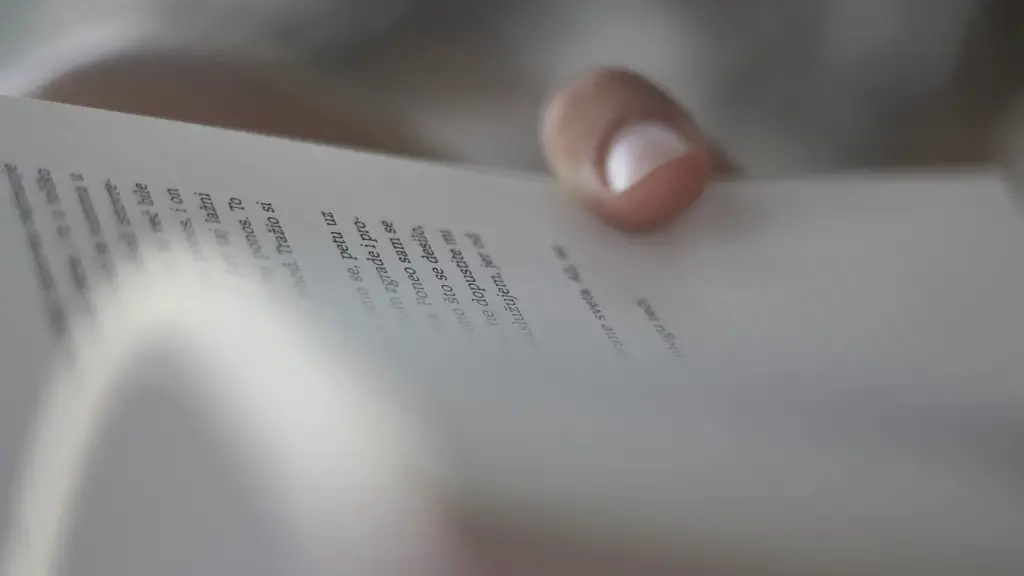Description of Slant Rhyme
Slant rhyme, also known as imperfect rhyme, is a form of rhyming poetry in which two words share some semblance of sound but don’t quite match up. The sounds don’t have to be exact for it to be considered a slant rhyme, and the nature of this type of rhyme is such that it allows poets to develop interesting sounds and meanings in otherwise ordinary words. Examples of common slant rhymes include ‘sleeve’ and ‘leaves’, ‘cone’ and ‘stone’, and ‘spark’ and ‘speak’.
Slant rhyme is used to to provide a kind of off kilter lyrical effect that is often reminiscent of spoken word poetry. The rhymes are generally viewed as softer or weaker than traditional rhymes, yet their impact can still be quite powerful. It is this strength that attracts so many contemporary poets, who often favor it over couched verse approaches.
Use of Slant Rhyme in Poetry
Slant rhymes are regularly used in modern poetry to create certain effects and convey certain meanings. While using slant rhyme can help to make a poem more personal and idiosyncratic, it can also help to keep certain parts of the poem more general and open-ended. For example, a poet may use half-rhymes to direct the reader’s focus on one specific word or phrase while also making use of a range of other words and phrases to hint at a larger meaning or idea.
Slant rhyme is often used when exploring a subject from multiple perspectives or talking about multiple ideas at once. By mixing in full rhymes with slant rhymes, a poet can break up and complicate their poem in a way that creates a sense of dynamism. This lets them explore and express different sides of a subject without having to make it entirely clear or obvious.
The Impact of Slant Rhyme on the Reading Experience
The use of slant rhyme has an influential impact on the way the reader experiences the text. As such, poets should consider how their use of slant rhyme will affect the readability of their poem.For instance, some poets may prefer to focus on the importance of sound and cadence in a poem over any literal interpretation of its words. In this case, poets may focus on creating interesting structures and sounds that give the poem its primary structure while minimizing any dependence on literal meaning.
On the other hand, some poets may prize literal interpretation over the way a poem sounds. In this case, the use of slant rhyme is still highly influential because it can be used to enhance the meaning of a poem. A poet may choose slant rhymes that have some kind of connotation to the words that are being rhymed. This can create an interesting context for the poem by allowing a reader to interpret the words within an existing framework.
The Role of Slant Rhyme in Poetry Writing
Slant rhyme plays an important role in the writing of poetry because it encourages poets to experiment with sound, meaning, and structure. It allows poets to create more complex poetry without disturbing the flow of their poem or confusing the reader. By including slant rhymes in their work, poets can manipulate the feeling and structure of their poem and thus create deeper, more nuanced poems.
Moreover, slant rhymes can help poets avoid the overuse of traditional rhymes. By mixing full rhymes with slant rhymes, poets can create a sense of rhythm and consistency in their poem without making it appear too predictable or formulaic. This not only helps to make the poem more engaging for the reader, but it also helps to create a more interesting and complex poem overall.
The Variety of Slant Rhymes
It’s important to note that slant rhyme is not limited to just two-word rhymes. Poets often use a variety of slant rhymes to create more complex patterns and sounds in their work. This includes using more effective lingual effects such as rhyming off-syllabic words, repeating sounds, and alliterative slant rhymes.
It can also include the practice of using multiple words to create a slant rhyme instead of just two. For example, poems can include ‘work-sound’ and ‘sing-bring’ to create a more rhythmical, dynamic sound. The use of these techniques helps to create an interesting and distinct sound for the poem, and encourages readers to pay attention to the words in a more expressive and meaningful way.
Exploring Metaphorical Possibilities with Slant Rhyme
Slant rhyme also provides poets with an opportunity to explore a range of metaphorical possibilities within their poetry. By utilizing slant rhymes, poets can connect words that have different meanings but still share a similarity, such as ‘hate’ and ‘weight’, or ‘dark’ and ‘park’. This can be a powerful tool for conveying multiple meanings within a poem and making the overall poem more thought-provoking and engaging.
The use of slant rhymes allows poets to create a range of interesting tensions in their work. This can enhance the meaning of a poem by allowing the reader to explore metaphor and realize the hidden meanings in the poem’s words.
Influencing The Meaning with Slant Rhyme Choice
When utilizing slant rhymes, poets should be aware of the specific words they choose to rhyme. The sound and meaning of the words can have a powerful impact on the overall message of the poem, especially when allusions and metaphors are involved. By deliberately choosing words that have similar sounds and different meanings, a poet can create a poem that is more compelling and enthralling.
In addition, one should consider how they themselves interpret the words within the poem. Any individual experiences or interpretations of the words may impact how the poem’s overall meaning is understood. For example, a poet may interpret the word ‘weight’ differently than the reader, which could ultimately affect the way the poem is interpreted as a whole.
Intentional Rhyme Variation In Poetry
The use of slant rhymes can also be used to intentionally add variation to a poem. This can be beneficial for poets who wish to explore different perspectives or take a creative approach to the subject matter. It forces a poet to search for words or ideas that have sufficiently similar sounds to create a pleasing and slightly hypnotic effect. This can add a sense of ebb and flow to the poem, giving it an interesting rhythm and structure.
Ultimately, slant rhymes are an important tool for poets to utilize in their craft. Utilizing slant rhymes can enhance the meaning of a poem by adding complexity to the sound and structure of the poem. By understanding the implications of slant rhymes and deliberately choosing them to create more engaging and nuanced poems, poets can craft works of art that are truly striking and evocative.
Using Slant Rhyme to Create Tension and Interest
Slant rhyme can be used to create tension or surprise in a poem. For example, a poet may decide to use a full rhyme in one line, and a slant rhyme in another, allowing for a kind of creative play between the two sounds. This can add interest and tension to a poem, which can help it stand out amongst other
works.
Moreover, poets can use their understanding of traditional and slant rhymes to experiment with different approaches to rhyming. By juxtaposing traditional and slant rhymes, poets can create a new perspective and understanding of the words they are using. This can lead to innovative and captivating verses that are more emotionally engaging and that leave a lasting impression on the reader.
Exploring Patterns of Slant Rhyme in Poetry
It’s important to note that slant rhyme is not restricted to just two-word rhymes. Poets can use a variety of slant rhymes to create more complex patterns and sounds in their work. This includes using more effective lingual effects such as rhyming off-syllabic words, repeating sounds, and alliterative slant rhymes.
It can also include the practice of rhyming multiple words together, such as ‘work-sound’ and ‘sing-bring’, to create a more rhythmical, dynamic sound. This helps to create an interesting and distinct sound for the poem, and encourages readers to pay attention to the words in a more expressive and meaningful way.
Exploring the Effects of Slant Rhyme in Poetry
Slant rhyme can have a profound impact on the way a poem is read and understood. By using slant rhyme, poets can create an atmosphere of complexity, mystery, and intrigue, which can be a powerful tool for conveying deeper messages in the poem. Additionally, slant rhyme can help poets communicate more effectively with their readers and create an immersive reading experience.
Finally, the use of slant rhyme can create a sense of tension and surprise in a poem. By juxtaposing traditional and slant rhymes, poets can create new and unexpected patterns that give their poem a unique and captivating atmosphere. This can help to engage the reader and create more memorable works of poetry.





